A Traveler’s Guide to Kaiping Diaolou and Its Charming Villages
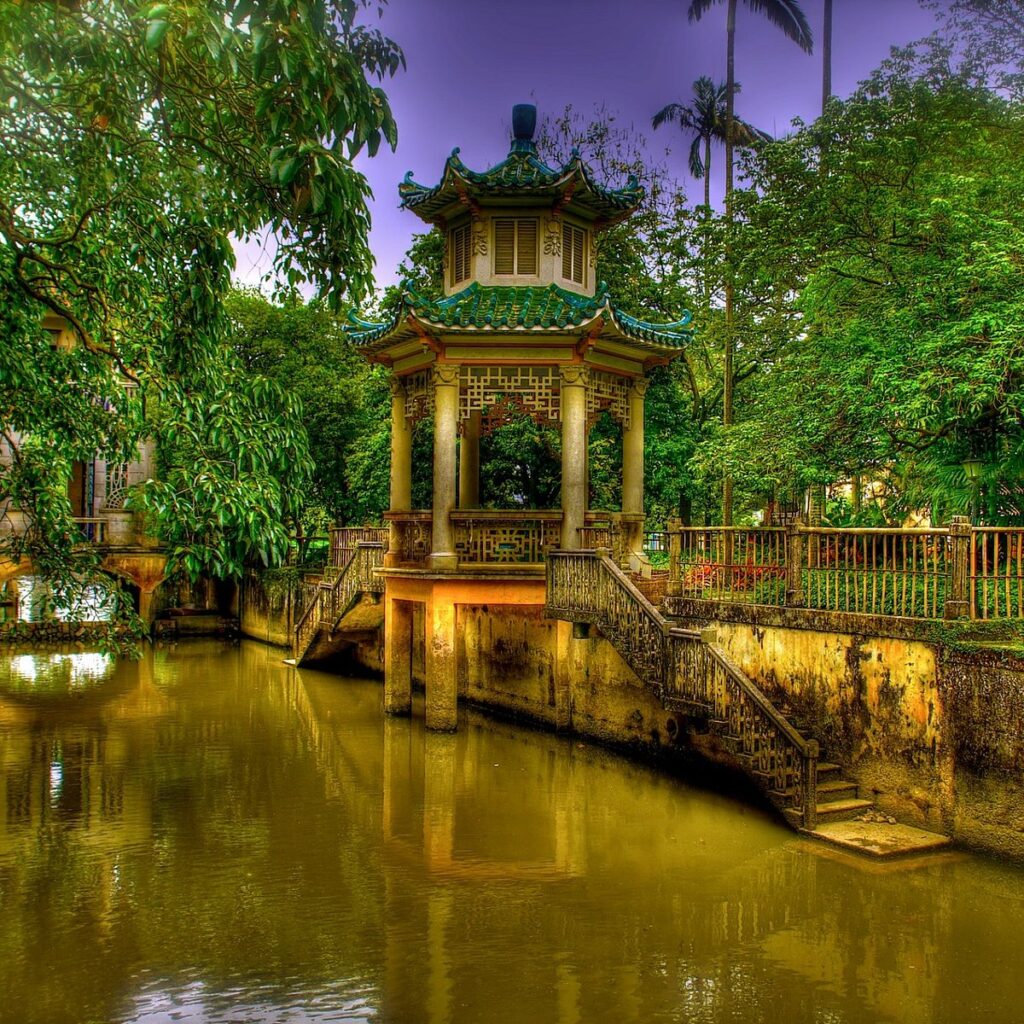
An Essential Guide to Visiting Kaiping Diaolou And Villages
Nestled in the heart of Guangdong province, Kaiping Diaolou and Villages offer an enchanting glimpse into China’s architectural heritage and rich history. Renowned for their distinctive multi-story watchtowers, known as diaolou, these structures were constructed by returning overseas Chinese immigrants between the 17th and early 20th centuries. Originally built for defense against bandits, these eclectic towers blend traditional Chinese styles with Western influences, creating a unique visual landscape.
Designated as a UNESCO World Heritage site, the diaolou stand as a testament to the resilience and ingenuity of the local culture. As you wander through the tranquil villages like Zili and Majianglong, you’ll discover not just remarkable buildings, but also the stories of the families who once inhabited them. The picturesque countryside, dotted with lush greenery and breathtaking views, invites exploration and reflection.
Whether you’re an architecture enthusiast, a history buff, or simply seeking an off-the-beaten-path adventure, Kaiping promises a memorable experience. From guided tours that delve into the intricate histories of the diaolou to leisurely strolls through charming streets, this captivating destination is sure to leave an indelible mark on your travel journey. Prepare to be transported back in time as you uncover the secrets of Kaiping’s remarkable past and its vibrant present.
In This Guide
- An Essential Guide to Visiting Kaiping Diaolou And Villages
- The Rich History and Legends of Kaiping Diaolou And Villages
- Main Highlights: What You Absolutely Can’t Miss
- Planning Your Visit: A Practical Guide
- Tickets: Prices, Booking, and Tips
- How to Get There: A Complete Transportation Guide
- Local Cuisine and Accommodation Nearby
- Frequently Asked Questions
- Final Thoughts on Your Trip
The Rich History and Legends of Kaiping Diaolou And Villages
Nestled in the heart of Guangdong Province, Kaiping is a treasure trove of history and culture, primarily known for its iconic Diaolou — a term that translates to “watchtower” in Chinese. These remarkable towers, constructed between the 17th and 20th centuries, are not just architectural marvels; they embody the rich tapestry of Kaiping’s past, steeped in stories of resilience and innovation.
The origins of the Diaolou can be traced back to the tumultuous socio-political climate of the late Ming and early Qing dynasties. As banditry surged in the region, local residents sought refuge in fortified structures that combined defensive capabilities with domestic living quarters. These multi-story towers, often adorned with intricate carvings and eclectic architectural styles, reflect a blend of traditional Chinese design and Western influences, a testament to the overseas connections of many Kaiping villagers who emigrated to places like the United States and returned with foreign aesthetics.
Between the 19th and early 20th centuries, the wealth generated from overseas Chinese migrants contributed significantly to the construction of these grand structures. Families who had prospered abroad invested in building lavish Diaolou, often featuring elaborate motifs and spacious interiors. Today, several clusters of these towers have gained UNESCO World Heritage status, highlighting their architectural significance and unique cultural heritage.
Beyond their physical grandeur, the Diaolou are imbued with legends and local folklore. Tales of ancestral spirits safeguarding the towers, as well as stories of love and loss, are woven into the fabric of village life. Each watchtower has its own narrative, often reflecting the family lineage and the tumultuous history of the region. For instance, the Yinonglu Villa in Zili Village stands tall not only for its height but also for its connection to the local community’s history, offering breathtaking views of the surrounding countryside that tell stories of the past.
Visitors to Kaiping are not just treated to a visual feast; they are invited to step into a living museum where the echoes of the past resonate in the present. Strolling through the serene villages, one can appreciate the juxtaposition of the rustic landscapes with the grandeur of the Diaolou. The tranquility of the countryside, dotted with these impressive structures, allows travelers to immerse themselves in the rich heritage of the area.
As you explore Kaiping, remember that each Diaolou is a silent witness to the trials and triumphs of its inhabitants. From a defensive stronghold against bandits to a symbol of prosperity and cultural exchange, the Diaolou and the villages surrounding them embody the spirit of resilience and adaptability that defines this unique region of China. Whether you’re an architecture enthusiast, a history buff, or a curious traveler, the allure of Kaiping’s Diaolou is sure to leave an indelible mark on your journey.
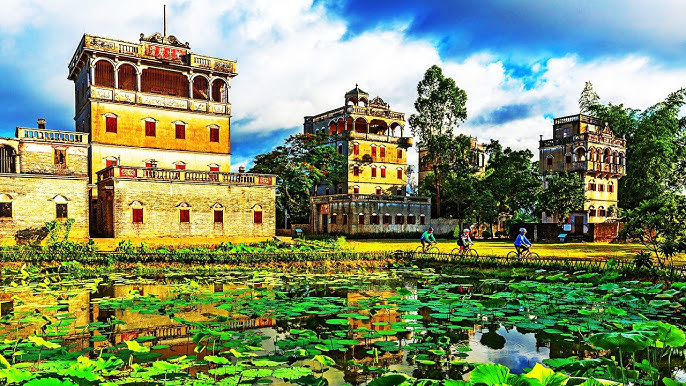
Kaiping Diaolou And Villages.
Main Highlights: What You Absolutely Can’t Miss
When you embark on a journey to Kaiping Diaolou and Villages, you step into a world where history, architecture, and stunning landscapes converge. This UNESCO World Heritage site is renowned for its unique watchtowers, known as diaolou, which reflect a rich cultural tapestry woven from Chinese and Western influences. Here are the main highlights you absolutely cannot miss during your visit:
1. The Iconic Diaolou Towers
The heart of Kaiping lies in its remarkable diaolou. These multi-story structures, built between the 17th and early 20th centuries, served as both homes and fortifications against banditry. Explore the architectural diversity of these towers, which feature a blend of Gothic, Baroque, and traditional Chinese designs. Zili Village, in particular, is home to some of the most famous diaolou, including the impressive Yinonglu Villa, which boasts spectacular views from its top level.
2. Zili Village
Zili Village is a must-visit for any traveler. This charming locale is not only picturesque but also encapsulates the essence of the Kaiping region’s unique architectural style. Stroll through the village, where vibrant gardens and serene ponds create a tranquil atmosphere. Don’t forget to cross the colorful wooden walkway that leads to the diaolou buildings, offering a perfect photo opportunity.
3. Li Garden
Make a stop at Li Garden, which serves as a visitor center providing essential information and tickets to the various villages. Here, you can enjoy a delightful meal and recharge before exploring the surrounding areas. The garden itself is a peaceful retreat, showcasing beautiful landscaping that complements the historical architecture.
4. Chikan European Style Street
Just a short distance from the diaolou, Chikan Street offers a fascinating glimpse into the colonial past of the area. This charming street is lined with European-style architecture, cafes, and shops that exude an old-world charm. It’s the perfect place to unwind, enjoy a cup of coffee, and soak in the local atmosphere.
5. Majianglong Village
Another gem in the Kaiping region, Majianglong Village is lesser-known but equally captivating. This village features a collection of well-preserved diaolou and offers a more authentic glimpse into rural life. Take your time to explore the area, interact with locals, and appreciate the stunning countryside views.
6. Cultural Insights
Don’t miss the opportunity to learn about the history and significance of the diaolou during your visit. Many structures still contain original furniture and artifacts, offering a unique perspective on life in the region during its heyday. Engage with local guides who can provide deeper insights into the fascinating stories behind these architectural marvels.
7. Scenic Views
The flat landscape surrounding the diaolou provides unparalleled views of the countryside. Be sure to climb to the top of one or more diaolou for panoramic vistas that stretch for miles. The peaceful rural setting, dotted with rice paddies and traditional farms, is a perfect backdrop for memorable photographs.
8. Accessibility and Tours
Kaiping is conveniently located about 100 kilometers from Guangzhou, making it an accessible day trip. Numerous guided tours are available, offering a hassle-free way to explore the area’s highlights. Consider booking a private tour to ensure you maximize your experience and delve deeper into the region’s history.
Conclusion
A visit to Kaiping Diaolou and Villages is an unforgettable experience, rich in history, culture, and stunning architecture. Whether you’re wandering through the enchanting villages, marveling at the intricate designs of the diaolou, or enjoying the serene landscapes, this destination promises to leave a lasting impression. Prepare to be captivated by the unique stories that these towers and villages have to tell.
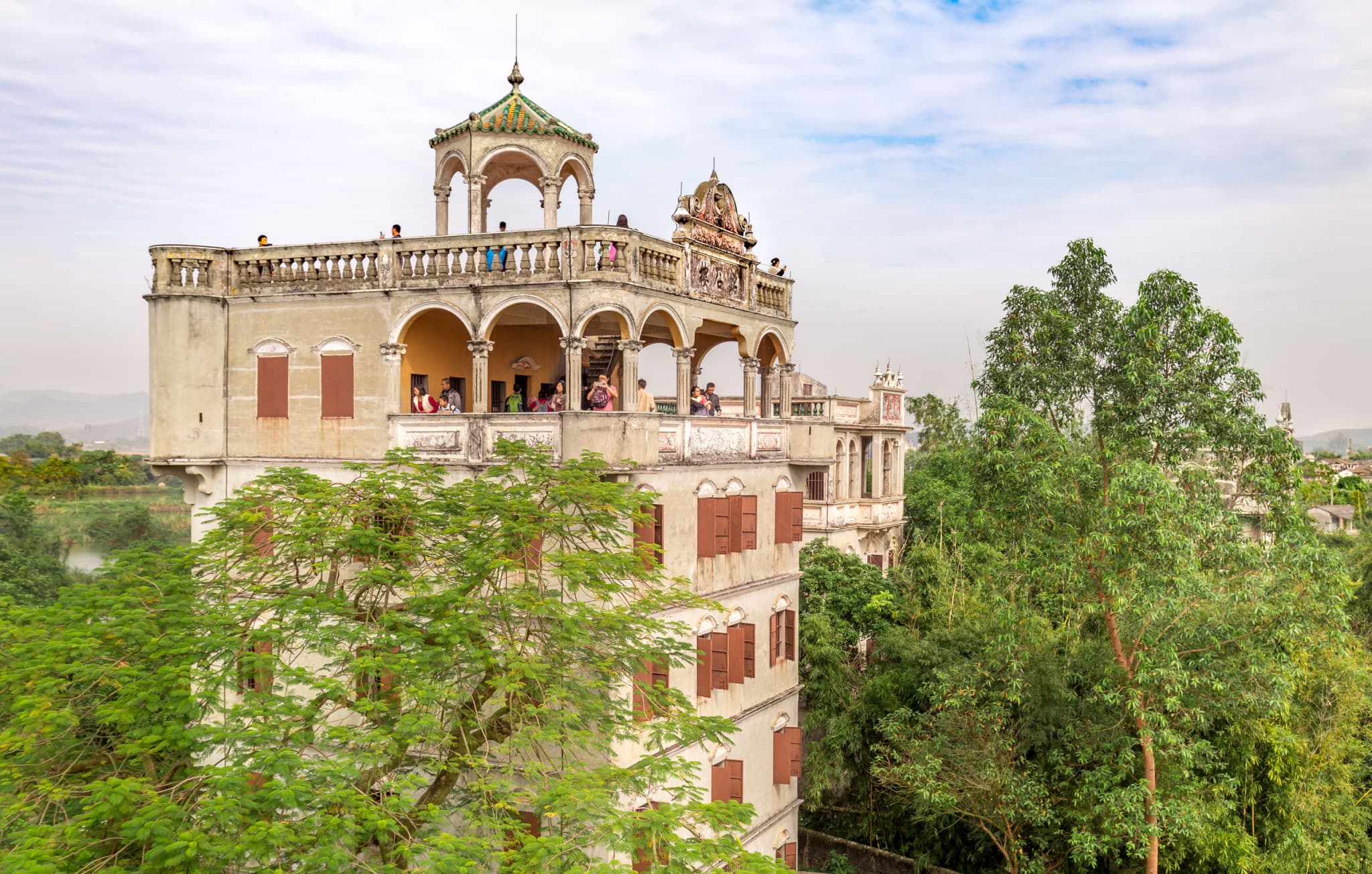
Kaiping Diaolou And Villages.
Planning Your Visit: A Practical Guide
Planning Your Visit to Kaiping Diaolou and Villages
Embarking on a journey to the enchanting Kaiping Diaolou and Villages is a chance to delve into the rich tapestry of Chinese history and architecture. These unique watchtowers, recognized as a UNESCO World Heritage site, offer a fascinating glimpse into the past. Here’s everything you need to know to make the most of your visit.
Getting There
Kaiping is located approximately 100 kilometers (62 miles) southwest of Guangzhou, making it easily accessible for international travelers.
- By Train: The fastest way to reach Kaiping is via high-speed train from Guangzhou. The journey typically takes around 1.5 hours.
- By Bus: Several bus services connect Guangzhou and Kaiping, with a travel time of about 2 to 3 hours.
- By Private Tour: If you prefer a more personalized experience, consider booking a private tour that often includes transportation, meals, and guided visits to key sites.
Best Time to Visit
The ideal time to explore Kaiping is during the cooler months, from October to April. The weather is generally mild, making it suitable for walking and exploring the villages. Avoid traveling during the summer months (June to August) when temperatures can soar and humidity can be uncomfortable.
Opening Hours
Kaiping Diaolou and Villages are open daily from 8:30 AM to 5:30 PM. It’s advisable to arrive early to avoid crowds, especially on weekends and public holidays.
Ticket Information
Entry to the Kaiping Diaolou and Villages typically requires a ticket, which can be purchased at visitor centers like the Li Garden Village. The ticket prices vary depending on the number of villages you wish to visit, so check in advance. Many tours also provide all-inclusive packages that cover entry fees.
Getting Around
The area is quite spread out, and while walking is a delightful way to soak in the scenery, consider these options for getting around:
- Bicycle Rentals: Many visitors enjoy biking through the countryside, and rentals are available near the visitor centers.
- Local Buses: A bus route connects the main villages, making it convenient for travelers to hop between sites.
- Guided Tours: Opting for a guided tour can enhance your experience, providing insights into the history and architecture of the Diaolou.
What to See
-
Zili Village: Known for its picturesque watchtowers and scenic pond, this village is a must-visit. The Yinonglu Villa, a six-story structure, offers stunning views of the surrounding area.
-
Majianglong Village: This village showcases a more traditional atmosphere and is less touristy, giving you a sense of local life.
-
Chikan Town: A charming spot featuring European-style architecture, cafes, and shops, perfect for a leisurely stroll.
-
Kaiping Garden: A beautiful landscaped area ideal for relaxation and photography.
Recommendations for Your Visit
- Wear Comfortable Shoes: You’ll be walking a lot, so comfortable footwear is essential.
- Stay Hydrated: Bring water, especially if you plan to explore extensively.
- Take Your Time: Allow yourself a full day to appreciate the historical significance and architectural beauty of the Diaolou.
- Photography: The unique structures and landscapes provide excellent photo opportunities, so keep your camera handy.
Local Cuisine
Don’t miss out on trying local delicacies! Look for restaurants near the visitor centers or in the villages where you can savor traditional dishes. The area is known for its rice dishes, fresh vegetables, and seafood, reflecting the local agricultural practices.
Cultural Respect
As you explore, remember that the villages are still inhabited, and many locals live and work in these areas. Maintain a respectful demeanor, especially when taking photographs or interacting with residents.
By following this guide, your visit to the Kaiping Diaolou and Villages will be both enjoyable and enlightening, allowing you to connect deeply with this unique part of China’s cultural heritage. Safe travels!
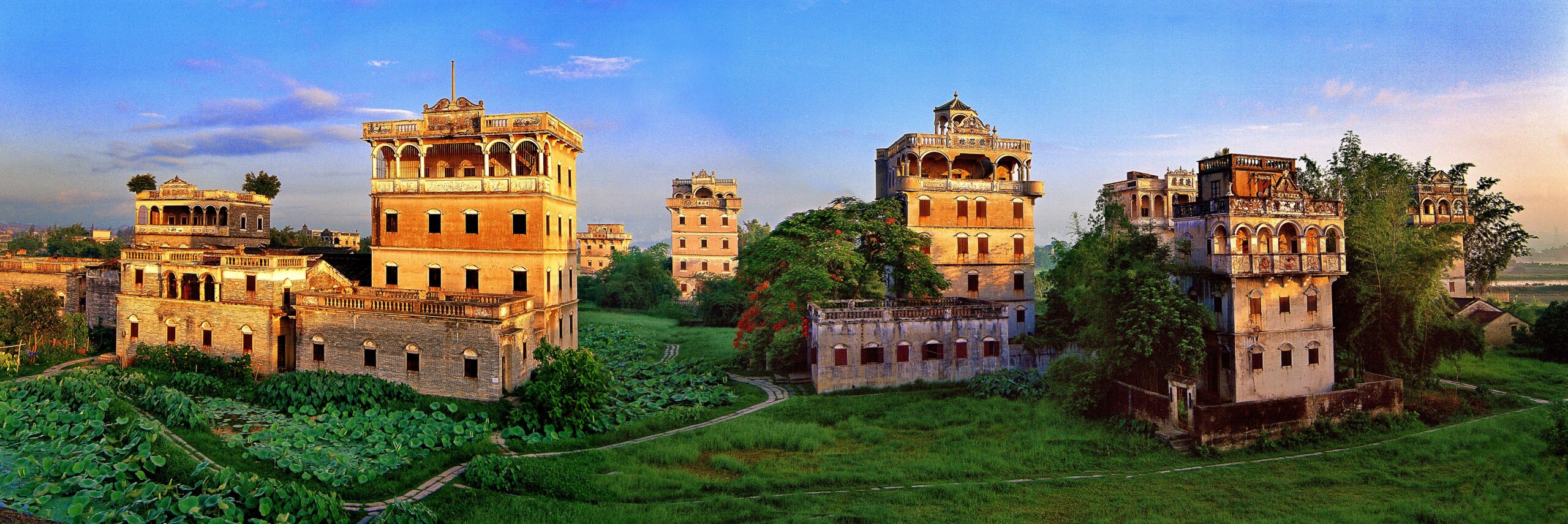
Kaiping Diaolou And Villages.
Tickets: Prices, Booking, and Tips
When planning your visit to the captivating Kaiping Diaolou and Villages, understanding ticket prices, booking options, and tips for a smooth experience will enhance your journey into this UNESCO World Heritage site.
Ticket Prices
Visitors can expect to pay around ¥60 to ¥100 (approximately $8 to $14 USD) for entrance tickets, depending on the specific village or cluster you choose to explore. Some notable areas include:
- Zili Village
- Majianglong
- Li Garden
These tickets often grant access to multiple watchtowers and facilities, allowing you to delve into the rich history and stunning architecture of the area.
Booking Options
While tickets can typically be purchased on-site, it’s advisable to book in advance, especially during peak tourist seasons. Various tour operators offer packages that include guided tours, transportation, and meals. For example, private day tours from nearby Guangzhou range from $200 to $365 per person, covering transportation and guided experiences of the Diaolou sites.
To reserve tours and tickets, consider:
- Online Booking Platforms: Websites like TripAdvisor and Viator provide user-friendly booking options for tours and experiences.
- Local Tour Operators: Research local companies that specialize in Kaiping tours, as they often provide unique itineraries and insights into the area.
Tips for a Great Visit
-
Plan Ahead: Allocate at least 3 to 4 hours for a thorough exploration of a single village. If you wish to visit multiple sites, consider a full day.
-
Transportation: If you’re not on a guided tour, check local bus schedules or consider renting a car to navigate the area easily. There’s a bus route connecting the villages, and it’s a scenic ride.
-
Visit the Visitor Center: Stop by the Li Garden Village visitor center for maps, information, and meal options. This is a great place to start your journey.
-
Best Time to Visit: Early morning or late afternoon are ideal for avoiding crowds and capturing the best photographs in the soft light.
-
Be Prepared for Walking: Wear comfortable shoes as you’ll be exploring various sites and may need to walk on uneven terrain.
-
Cultural Respect: As these villages are still inhabited, be mindful of the local customs and practices during your visit.
By following these guidelines, you will ensure a memorable and enriching experience at the Kaiping Diaolou and Villages, where history and architecture come alive in breathtaking fashion.
How to Get There: A Complete Transportation Guide
Reaching the enchanting Kaiping Diaolou and Villages is an adventure in itself, as it combines scenic views with cultural immersion. Whether you’re coming from nearby cities or traveling from afar, this guide will help you navigate your way to this UNESCO World Heritage site smoothly.
From Guangzhou
By Train:
Guangzhou serves as the most convenient departure point. Take a train from Guangzhou South Railway Station to Kaiping. The journey usually takes about 1.5 to 2 hours. Upon arrival at Kaiping Railway Station, you can opt for a taxi or a local bus to reach the Diaolou area.
By Bus:
Buses from Guangzhou to Kaiping run frequently throughout the day. The journey takes approximately 2 to 2.5 hours. Buses depart from various terminals in Guangzhou, including the Provincial Bus Terminal. Once you arrive at the Kaiping Bus Station, you can take a taxi or a local bus to the Diaolou sites.
By Private Car:
For those who prefer flexibility, renting a car or hiring a private driver is a fantastic option. The drive from Guangzhou to Kaiping takes about 2 hours via the G4 Expressway. This option allows you to stop at picturesque villages and scenic spots along the way.
From Shenzhen
By Train:
Shenzhen travelers can take a high-speed train to Kaiping. The journey typically lasts around 2.5 hours. From Kaiping Railway Station, you’ll find taxis and buses waiting to take you to the Diaolou and Villages.
By Bus:
Direct buses from Shenzhen to Kaiping are available, taking around 3 hours. Departures are frequent, so check local schedules. Upon arrival, you can use local transport to reach your destination.
Local Transportation in Kaiping
Once in Kaiping, navigating to the Diaolou sites is relatively straightforward. The primary locations, such as Zili Village and Chikan Town, are popular among tourists, and local transport options abound:
Public Bus:
There is a bus route that connects the key Diaolou villages, making it easy to hop between them. Buses are affordable and run frequently during the day.
Taxis and Ride-Sharing:
Taxis are readily available and can be a convenient option, especially if you are traveling in a group. Alternatively, apps like Didi (similar to Uber) are also operational in the area.
Bicycle Rentals:
For the more adventurous, renting a bicycle allows you to explore the countryside at your own pace. Several local shops offer rental services, and the flat terrain makes cycling an enjoyable way to see the sights.
Conclusion
Getting to Kaiping Diaolou and Villages is a journey filled with anticipation. Whether by train, bus, or car, the route offers glimpses of China’s rich cultural tapestry. Once there, local transport options will facilitate your exploration of these architectural wonders. Be sure to take your time and enjoy the unique charm of this remarkable region!
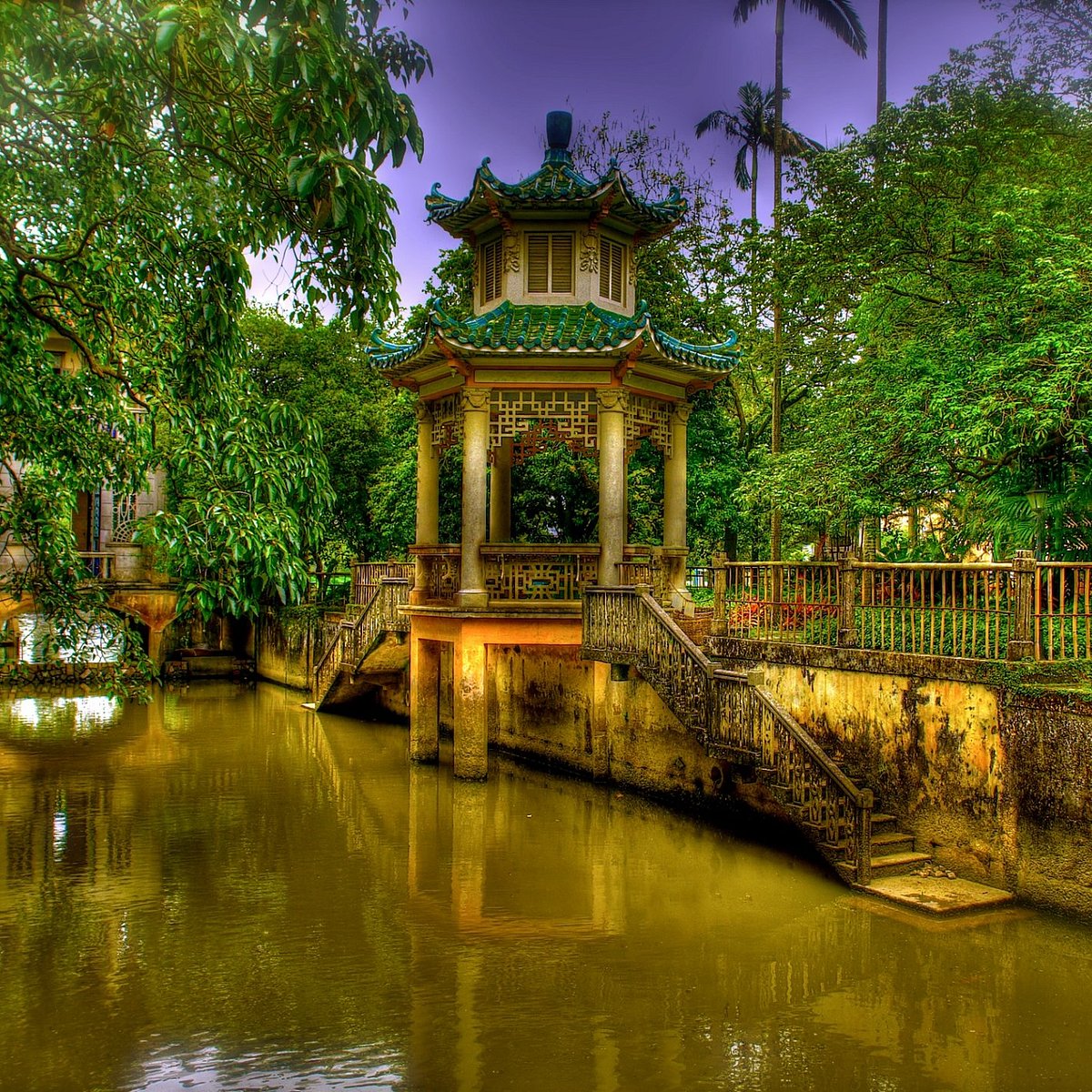
Kaiping Diaolou And Villages.
Local Cuisine and Accommodation Nearby
Exploring the enchanting Kaiping Diaolou and Villages offers not only a glimpse into the unique architecture of these UNESCO World Heritage sites but also an opportunity to savor the local cuisine and find comfortable accommodations nearby.
Culinary Delights
When it comes to local dining, the Kaiping area is known for its delectable Cantonese cuisine, with an emphasis on fresh ingredients and vibrant flavors. Here are a couple of must-try dining spots:
-
Li Garden Village Visitor Centre Restaurant
Located conveniently near the entrance to the Kaiping Diaolou, this restaurant is a popular choice among travelers. The menu features classic Cantonese dishes, including stir-fried vegetables, steamed fish, and aromatic rice. Don’t miss their signature dish, the Kaiping Beef, known for its tender texture and rich flavor. -
Chikan European Style Street
Just a short drive from the Diaolou, this charming area offers a variety of dining options, blending Chinese and Western culinary influences. Here, you can find quaint cafes serving everything from traditional dim sum to European pastries. The ambiance of the street, lined with historic architecture, adds to the overall experience. -
Zili Village Local Eateries
For a more authentic experience, wander into one of the local eateries in Zili Village. These family-run establishments often serve home-cooked meals, allowing you to taste regional specialties such as Hakka-style stuffed tofu or local seafood dishes. The warm hospitality and homey atmosphere make it a perfect stop for a satisfying meal after exploring the Diaolou.
Comfortable Stays
After a day of exploration, you’ll want a cozy place to rest. Here are some accommodation options that cater to various preferences:
-
Kaiping Diaolou Hotel
Situated close to the main attractions, this hotel features modern amenities with a touch of traditional decor. Guests can enjoy comfortable rooms with stunning views of the countryside, along with a restaurant that serves breakfast and local dishes. It’s an ideal base for travelers looking to explore the area. -
Chikan Ancient Town Boutique Hotel
This charming boutique hotel is nestled within Chikan’s historic district. With its beautifully restored architecture, the hotel offers a unique blend of old-world charm and modern convenience. Guests can enjoy elegantly decorated rooms and a lovely garden area for relaxation. The proximity to local attractions makes it a convenient choice. -
Zili Village Homestays
For those seeking an immersive experience, consider staying in one of the homestays in Zili Village. These accommodations offer a chance to live like a local, with comfortable rooms and homemade meals prepared by your hosts. Engage with the community and enjoy the serene rural surroundings.
Whether indulging in local flavors or resting in charming accommodations, your visit to Kaiping Diaolou and Villages promises a rich and memorable experience. Enjoy the unique blend of culture, history, and hospitality that this captivating region has to offer!
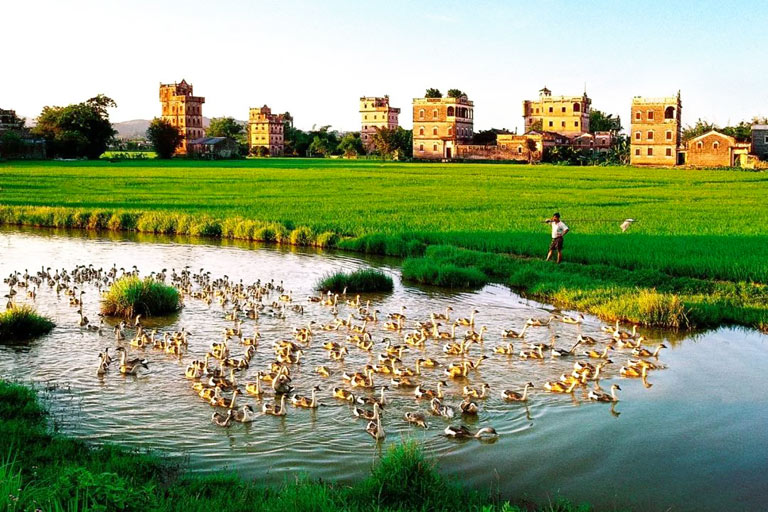
Kaiping Diaolou And Villages.
Frequently Asked Questions
Frequently Asked Questions
1. What are the Kaiping Diaolou and why are they significant?
The Kaiping Diaolou are unique, multi-story watchtowers built primarily between the 17th and 20th centuries. They served as fortifications against bandit raids and are recognized for their eclectic blend of Chinese and Western architectural styles. The site is designated as a UNESCO World Heritage site, making it a significant cultural and historical landmark in China.
2. How do I get to the Kaiping Diaolou and Villages?
Kaiping is located approximately 100 kilometers (about 62 miles) from Guangzhou. The most convenient ways to reach the area include taking a bus or booking a private tour. Several tours offer day trips from Guangzhou, which typically include transportation and guided visits to the notable villages.
3. What is the best time to visit the Kaiping Diaolou?
The best time to visit Kaiping is during the spring (March to May) and autumn (September to November) when the weather is mild and pleasant. These seasons also provide beautiful scenery, making your exploration of the villages even more enjoyable.
4. How long should I plan to spend at the Kaiping Diaolou?
Visitors typically spend more than three hours exploring the Diaolou and surrounding villages. However, if you wish to delve deeper into the history and architecture, consider allocating a full day, especially if you plan to visit multiple villages.
5. Are there guided tours available?
Yes, there are numerous guided tour options available, ranging from half-day to full-day excursions. Many tours include transportation from nearby cities like Guangzhou or Shenzhen and often provide insights into the history and architecture of the Diaolou.
6. What should I wear while visiting?
Comfortable footwear is recommended, as you’ll likely be doing a fair amount of walking. Given that some areas may have uneven terrain, sturdy shoes will enhance your experience. Additionally, consider dressing in layers, as temperatures can vary throughout the day.
7. Are there facilities like restrooms and food options nearby?
Yes, there are visitor centers in the area, such as the one at Li Garden Village, which offer restroom facilities and dining options. You can enjoy local cuisine before or after your exploration of the Diaolou.
8. Can I take photographs inside the Diaolou?
Photography is generally permitted in most areas, but it’s always best to check for any specific restrictions at each site. Many visitors enjoy capturing the unique architecture and stunning landscapes, so be sure to bring your camera!
Final Thoughts on Your Trip
As your adventure through the enchanting Kaiping Diaolou and Villages comes to a close, take a moment to reflect on the rich tapestry of history and culture that this UNESCO World Heritage site offers. The striking watchtowers, with their unique blend of Chinese and Western architectural styles, stand as silent sentinels of a bygone era, narrating tales of resilience, defense, and community. Each step through the lush countryside and quaint villages reveals not just the beauty of the structures but also the stories of the families who once called them home.
From the panoramic views atop the towers to the tranquil strolls along the scenic paths connecting the villages, Kaiping invites you to immerse yourself in its serene atmosphere. Whether you explored the vibrant Zili Village or marveled at the grandeur of the Yinonglu Villa, the memories forged here are sure to linger long after your departure.
As you depart, carry with you the essence of Kaiping—a celebration of architectural ingenuity and a testament to the enduring spirit of its people. This hidden gem in Guangdong Province beckons for future visits, promising new discoveries and deeper connections with its unique heritage. Safe travels, and may your journey continue to inspire wanderlust wherever you go!